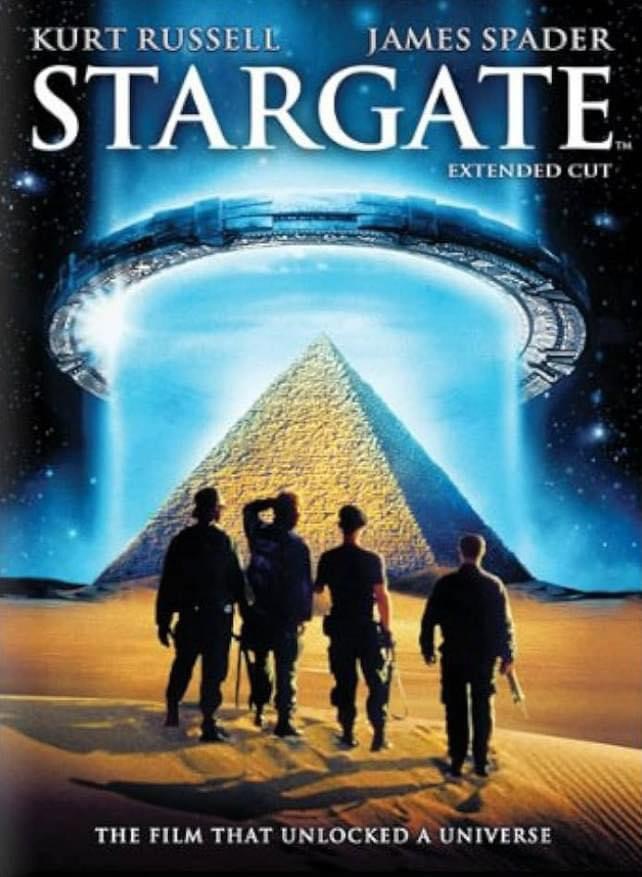Stargate (1994)

Released in 1994 and directed by Roland Emmerich, Stargate is a pioneering sci-fi adventure that combines elements of archaeology, ancient mythology, and military sci-fi in a unique and ambitious story. Starring Kurt Russell as Colonel Jack O’Neil and James Spader as Dr. Daniel Jackson, the film centers around a mysterious ancient artifact that opens a gateway to a distant world, ultimately leading to an interstellar adventure that would lay the groundwork for a successful sci-fi franchise.
Suggested videos for you:
Plot Overview
The story begins when Dr. Daniel Jackson, an eccentric Egyptologist with unconventional theories about the origins of Egyptian civilization, is invited by the U.S. Air Force to decode a mysterious artifact discovered in the 1920s: a giant, ring-like structure inscribed with symbols. After successfully deciphering the symbols as coordinates for interstellar travel, Jackson and a team of military personnel, led by the battle-weary Colonel O’Neil, use the device (called the “Stargate”) to travel to a distant desert planet, Abydos.
On Abydos, they encounter a civilization eerily similar to that of ancient Egypt, controlled by a god-like alien ruler named Ra. Ra, who possesses vast powers and advanced technology, enslaves the local population, ruling over them as a deity. Jackson and O’Neil, along with a small group of soldiers, join forces with the locals to rebel against Ra and liberate Abydos. The film then becomes a battle for survival as Jackson and O’Neil try to return home while undermining Ra’s tyrannical grip on the planet.
Themes and World-Building
Stargate is heavily influenced by the idea of ancient astronaut theory, which suggests that advanced extraterrestrial beings influenced early human civilizations. This central theme sets the stage for a fascinating exploration of myth, technology, and power. By linking Ra to an alien race that masquerades as gods, the film provides a fresh spin on Egyptian mythology, blending it seamlessly with science fiction. The idea that gods of ancient civilizations were actually aliens in disguise opens up a universe of possibilities that Stargate would later expand upon in its television series adaptations.
The cultural details and set design on Abydos are rich and immersive, helping to establish a believable alien society grounded in ancient Earth mythologies. Costume designs and props inspired by ancient Egypt further help transport the audience into a world where the line between human history and alien technology blurs.
Character Development and Performances
Stargate is held together by the contrast between its two main characters, O’Neil and Jackson. Colonel O’Neil, played with stoic intensity by Kurt Russell, is a man burdened by loss and grief, having lost his son before the events of the film. Initially withdrawn and unyielding, he sees the mission as potentially his last. Russell brings an understated depth to O’Neil, making his eventual emotional arc — from despair to redemption — one of the film’s most compelling aspects.
On the other hand, James Spader’s Dr. Jackson is a brilliant, yet socially awkward academic who, in his idealism, becomes the film’s moral compass. Jackson’s enthusiasm, curiosity, and naivety contrast sharply with O’Neil’s jaded military experience, making their partnership an interesting dynamic. Spader’s performance adds a sense of warmth and innocence to the film, grounding the more fantastical elements in a genuine sense of wonder.
However, other characters in the film are less well-developed. Ra, played by Jaye Davidson, is an intimidating presence, yet his character lacks much backstory or motivation beyond simple tyranny. Davidson’s androgynous and haunting portrayal brings an air of alien menace to Ra, but the character’s motivations remain somewhat vague, giving him the feel of a stereotypical villain rather than a complex antagonist.
Visual Effects and Design
One of Stargate’s most remarkable features is its visual effects, which were groundbreaking for the time. The depiction of the Stargate portal itself — a shimmering pool of energy with an ethereal liquid quality — is stunning and remains iconic in the sci-fi genre. The filmmakers effectively use both practical effects and early CGI, creating memorable scenes like the wormhole travel sequence that transports the team to Abydos.
The sets on Abydos, with towering pyramids, desert landscapes, and ancient structures, are detailed and immersive, transporting audiences to an alien world that still feels oddly familiar. The costume and set designs for Ra’s guards, known as the Horus and Anubis guards, are especially notable, combining Egyptian-inspired motifs with an otherworldly, sci-fi aesthetic. Their stylized metallic headdresses and armor add to the atmosphere, making Ra’s forces appear both godlike and militarized.
Strengths and Weaknesses
One of Stargate’s biggest strengths is its ambition and originality. The concept of an interstellar portal tied to ancient human mythology was novel and remains one of the film’s most enduring contributions to science fiction. The film also balances action and adventure with exploration of philosophical themes, such as the nature of power, the ethics of colonialism, and the enduring human struggle for freedom.
However, Stargate does have its weaknesses, particularly in its pacing and plot structure. After the initial mystery surrounding the Stargate is revealed, the film’s pacing slows as the team explores Abydos, and it sometimes struggles to maintain momentum. Certain plot points, such as Ra’s motivations or the specifics of the Stargate’s origins, are left underdeveloped, which can make the story feel superficial at times.
Additionally, while Ra’s character design is compelling, his lack of depth as a villain limits the emotional stakes. As a result, much of the film’s tension rests on the visual spectacle and action sequences rather than deep character interactions or complex plot developments.
Reception and Legacy
Upon its release, Stargate received mixed to positive reviews, with critics praising its imaginative premise and impressive special effects while pointing out its flaws in pacing and character development. Despite these critiques, it became a commercial success, grossing nearly $200 million worldwide and becoming a cult classic. Its unique concept and world-building inspired a dedicated fan base, eventually leading to the creation of a long-running television franchise, beginning with Stargate SG-1 in 1997, which expanded the universe and further explored its mythology and themes.
The Stargate franchise grew to become one of the most beloved in sci-fi television, spawning multiple spin-offs, including Stargate Atlantis and Stargate Universe. The film’s impact on science fiction can be seen in its influence on subsequent movies and TV shows that explore similar themes of interstellar travel, ancient aliens, and human origins.
Conclusion
Stargate is a visually stunning and thought-provoking sci-fi adventure that offers a unique blend of mythology and futuristic technology. While it has its flaws, such as some underdeveloped characters and pacing issues, the film’s ambitious concept, memorable visuals, and strong lead performances make it a compelling watch. Its success and legacy paved the way for one of sci-fi’s most expansive and beloved franchises, earning it a place as a foundational piece of 1990s science fiction.
For those interested in imaginative, adventure-driven sci-fi that mixes ancient history with futuristic themes, Stargate is a must-watch. Its legacy, more than anything, is a testament to its original vision, and it remains a landmark film in the genre that continues to resonate with audiences decades after its release.











